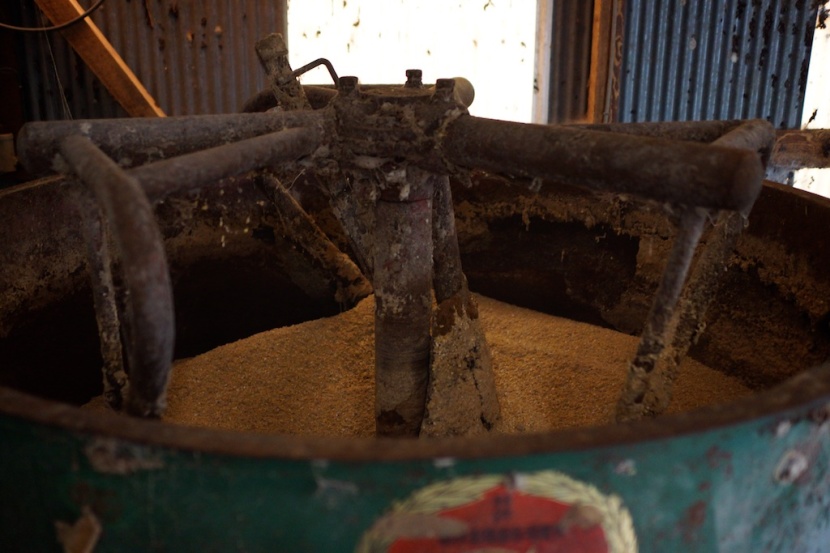
Livestock: Organic Chicken Feed in Japan
Organic egg production is a fast and relatively simple way to develop a consistent income stream for your small farm. Egg-laying hens are inexpensive, easy to take care of, and produce approximately 1 egg per day per bird.
Because Japan suffers multiple natural disasters each year, ranging from earthquakes to tsunamis, “free-range” chickens are kept in coops. There is a benefit to this set up, especially if you live in a rainy climate.
Feeding
In Japan, the ingredients used in the recipes below come in 20 kilogram bags. When I indicate the number of bags required, I’m assuming 1 bag weighs 20 kg. Depending on your location, this may or may not be helpful.

Chicken Feed
| Corn (Post Harvest Free) | 122 kg | 268.4 lb | 65.8% | 6.1 bags |
| Rice Bran | 15 kg | 33 lb | 8.1% | 0.75 bags |
| Fish Meal | 16 kg | 35.2 lb | 8.7% | 0.8 bags |
| Soy Bean Meal | 15 kg | 33 lb | 8.1% | 0.75 bags |
| Oyster Shell | 13 kg | 28.6 lb | 7.1% | 0.65 bags |
| Feed Bokashi | 3.3 kg | 7.3 lb | 1.8% | |
| Bat Guano | 0.8 kg | 1.8 lb | 1.8% | |
| Sea Salt | 0.2 kg | 0.4 lb | 0.1% |
This recipe produces 184.3 kg (406.5 lb) of feed, enough to keep 100 egg-laying hens fed for 1 week. You can adjust the recipe by multiplying each weight by x/100, where x represents the number of hens you have.
A large commercial mixer makes it easy to prepare this feed recipe on a weekly basis. Shinji-san obtained several large mixers for free from the families of former farmers. They didn’t know what to do with the old equipment and were grateful he was willing to remove it from their property.
Feed Bokashi
| EM | 200 cc | 6.8 fl oz |
| Molasses | 200 cc | 6.8 fl oz |
| Rice Bran | 20 kg | 44 lb |
| Wheat Bran | 20 kg | 44 lb |
To create the feed bokashi, mix equal parts rice and wheat bran with some EM and molasses. The EM inoculates the mixture with beneficial microorganisms, while the molasses provides fuel for fermentation and food to propogate the microorganisms. The amount of water you add to the mixture greatly affects the fermentation process, so add water slowly to be sure you get it just right.
The best way to check the moisture content is by taking a handful of the mix and squeezing it.
| Moisture Content | Result of Squeezing Mixture |
|---|---|
| Just Right | Mixture clumps together. |
| Too Little | Mixture crumbles in your hand. |
| Too Much | Water drips out between your fingers. |
If you need to mix in more water, do it slowly and test frequently. If you have too much water, you can balance the mixture by adding more rice and wheat bran in equal parts. When you get the moisture content just right, dump it into a plastic bag and push all the air out. You want the mixture to undergo fermentation, and it can only do this in the absence of air. Let the bag sit for 2 weeks, then take a whiff. When you can smell the fermentation, it is ready for use.
Yogurt
If there are dairy producers in your area, you may be able to secure a source of free yogurt that can supplement your poultry’s diet. Yogurt provides calcium, which hens use to create strong egg shells, and inoculates your animals with lactobacillus and other probiotics that will help keep them healthy and productive.
In Japan, sometimes it takes regulators so long to test milk and yogurt products at small dairy farms that the products expire and are no longer fit for human consumption. Shinji-san collects expired bottles and cartons of milk, canisters of yogurt, and other items that are no longer fit for sale from local dairy farmers for free.
He combines these products in a large, unrefrigerated tub that is loosely covered with plastic boards. When milk is added to yogurt and left to sit, its converted into more yogurt. Shinji-san’s flock is split between two coops of 50 birds. He fills one large watering bowl per coop with the mixture once a day. Because the tub isn’t sealed air-tight, it is normal to find insects in the mixture. The chickens don’t mind; they love gobbling up bugs as much as they love the yogurt.
Matt
Latest posts by Matt (see all)
- Livestock: Organic Chicken Feed in Japan - July 8, 2020
- Farmer: Shinji Hashimoto - May 6, 2015
- Yoga for Cyclists - January 3, 2015
- Personal Care: Isao’s Natural Hair Oil - November 7, 2014
One Response to “Livestock: Organic Chicken Feed in Japan”


Were to buy this chicken feed in Japan ?